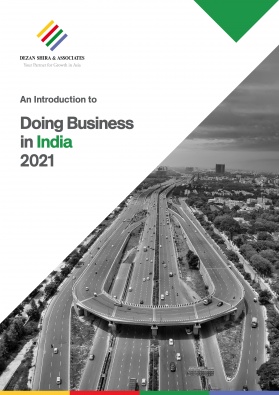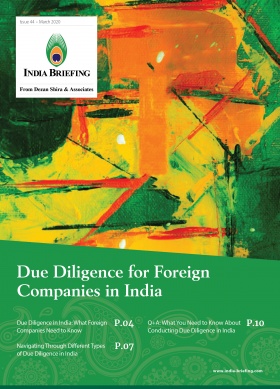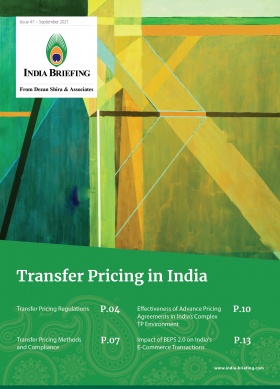India’s Automotive Ecosystem: A Primer for Investors
We provide a comprehensive overview of India’s automotive ecosystem, including the temporal analysis of automotive manufacturing capability, sales pattern of different automobiles segments, and major regional production clusters. We also provide insights into the auto components industry. Lastly, we highlight existing policy support and incentive measures provided to the sector.
India’s annual automobile manufacturing capacity in the financial year (FY) 2021 stood at 22.65 million vehicles, including passenger vehicles, commercial vehicles, three wheelers, two wheelers, and quadricycles, of which 4.13 million accounted for exports.
Industry estimates project the market size of the Indian automobile sector to reach US$300 billion by 2026, registering a significant growth from the existing US$118 billion in 2020.
Additionally, the automotive sector contributes 7.1 percent to India’s gross domestic product (GDP) and employs a workforce of 37 million. The Automotive Mission Plan 2016-26 (AMP) envisages to raise the sector’s share in GDP to 12 percent and create employment opportunities for over 65 million people.
Indian automobile market: Key players and manufacturing clusters
Regional clusters in India
Over the past few years, four specific regions in the country have emerged as large automobile manufacturing clusters.
Northern region
Delhi-Gurgaon-Faridabad
The major players in the northern region are Ashok Leyland, Force Motors, Piaggio, Swaraj Mazda, Amtek Auto, Eicher, Honda SIEL, Maruti Suzuki, Tata Motors, Bajaj Auto, Hero Group, Escorts, ICML, JCB, Yamaha, Mahindra, Suzuki Motorcycles.
Eastern region
Kolkata-Jamshedpur
The key players in the eastern region are Tata Motors, Hindustan Motors, Simpson and Company, International Auto Forgings, JMT, Exide.
Western region
Mumbai-Pune-Nashik-Aurangabad
The major players in the western region are Ashok Leyland, Bajaj Auto, FIAT, Mahindra and Mahindra, Eicher, Skoda, Bharat Forge, Tata Motors, Volkswagen, Renault Nissan, John Deere, Mercedes Benz, Tata Hitachi West, Volvo Eicher.
Southern region
Chennai-Bengaluru-Hosur
The key players in the southern region are Ashok Leyland, M&M, Toyota Kirloskar, Volvo, Sundaram Fasteners, Enfield, Hyundai, BMW, Bosch, TVS Motor Company, Renault Nissan, TAFE, Daimler, Caterpillar, Hindustan Motors.
Major vehicle market players
Some of the leading players in India’s automobile industry are Tata Motors, Maruti Suzuki, Mahindra and Mahindra, etc. Leading foreign players, including Kia Motors and Volkswagen, have customized their products in terms of traditional structure and designs to cater to the large Indian middle-class population. This is essential for them to compete directly with domestic firms as the sector is highly competitive.
Tata Motors introduced the Ace Gold Petrol CX in July 2021, which is India’s cheapest and most compact commercial four-wheeler vehicle, starting at INR 3,99,000 (US$5,362).
Hyundai too entered a strategic alliance with shared mobility company, Revv, in 2018, under which it intends to provide cars on subscription in six cities in India. This will provide customers the opportunity to use Hyundai’s models with hassle-free ownership and limited commitment.
Leading trends in India’s automobile market
The Indian automobile sector is categorized into four segments:
- Two wheelers: moped and electric scooters, scooters, motorcycles
- Three wheelers: passenger carriers, goods carriers
- Passenger vehicles: passenger cars, utility vehicles, multi-purpose vehicles
- Commercial vehicles: light commercial vehicles (LCV), medium and heavy commercial vehicles
The two wheelers and passenger vehicles segments dominate the market, claiming highest demand share of 81.2 percent and 14.6 percent, respectively. In FY 2021, two wheelers and passenger vehicles accounted for a combined sale of over 17.8 million vehicles. In the passenger vehicle segment, small and mid-sized cars dominate the sales figure.
Annual production of automobiles in India show a compound annual growth rate (CAGR) of 2.36 percent. From an annual production capacity of 24.02 million in FY 2016, the production capacity peaked in FY 2019 with 30.92 million units. However, the industry has since been hit by the COVID pandemic-led slowdown, with annual production falling to 22.65 million in FY 2021. In June 2021, the automobile production in India, comprising of passenger vehicles, three wheelers, two wheelers, and quadricycles stood at 1,693,639 units.
Simultaneously, a similar analysis of domestic annual sales of automobiles in India shows a CAGR of 1.29 percent. While the annual sales figures stood at 20.47 million in FY 2016, they peaked in FY 2019 at 26.27 before slumping to 18.61 million in FY 2021. However, the industry estimates look promising as the first quarter (Q1) of FY 2021-22 witnessed a 113 percent growth in the total domestic sales of vehicles. In June 2021, sales volume of passenger vehicles in India stood at 231,633 units.
Passenger vehicles
In FY 2021, passenger vehicles domestic sales stood at 2,711,000 units. As per the Federation of Automobile Dealers Associations (FADA), passenger vehicle sales in June 2021 stood at 184,134 units, compared with 1,28,360 units in June 2020.
Commercial vehicles
In FY 2021, commercial vehicles production, domestic sales stood at 448,914 units. Tata Motors recorded sales of 22,100 commercial vehicles in June 2021.
Two wheelers
As per June 2021 statistics, Hero MotoCorp and Honda Motorcycle and Scooter India (HMSI) surfaced as the top two players in the two-wheelers segment, with 44.65 percent and 21.14 percent market shares, respectively. Hero MotoCorp Ltd. recorded sales of 415,366 two-wheeler units in June 2021.
Three wheelers
Bajaj Auto emerged as the leader in the three-wheeler passenger category with 33.43 percent market share in June 2021, followed by Piaggio vehicles claiming a share of 15.33 percent. Bajaj Auto’s three-wheeler sales stood at 4,925 units in June 2021.
Luxury vehicles
The luxury car market in India registered annual sales of 19,781 units in FY 2021. This was a major drop from 60,637 units sold in FY 2020. In FY 2021, Mercedes Benz topped the list with 7,087 units sold, followed by Jaguar (1,696 units), Volvo (1,197 units), and Audi (404 units).
The luxury vehicle segment is expected to rebound in FY 2022, likely propelled by the introduction of new luxury products in 2021, which presently line up to a total of 70 new launches. New products include 25 new units by BMW, 15 units by Mercedes Benz, 10 units by Jaguar Land Rover, seven units by Audi, five units by Volvo, and the remaining from manufacturers like Rolls Royce, Lamborghini, Ferrari, and Porsche.
Electric vehicles to lead the automobile sector recovery
According to industry projections, the Indian automobile industry is expected to record strong growth in FY 2021-22, suggesting a swift recovery from the COVID-19 pandemic.
Electric vehicles, especially electric two wheelers, are likely to witness positive sales in FY 2022, given the persistent push by both the central as well as state governments for a transition towards cleaner mobility in India, including the most recent production-linked incentive (PLI) scheme for the automobile sector to boost the manufacturing of electric vehicles and hydrogen fuel cell vehicles.
According to an independent study by CEEW Centre for Energy Finance (CEEW-CEF), the EV market in India will be a US$206 billion opportunity by 2030. This will necessitate a US$180 billion investment in vehicle manufacturing and charging infrastructure.
For a detailed review of the Electric Vehicle Industry in India, click here.
Opportunities in the Indian automobile sector
According to AMP 2016-26, India is expected to emerge as the third-largest automotive market in the world in terms of volume by 2026, followed by China and USA.
India’s electric vehicles market will be a US$206 billion opportunity by 2030, requiring at least US$180 billion in investments in manufacturing and charging infrastructure.
The foreign investors have a huge opportunity as India allows 100 percent foreign direct investment (FDI) in the sector under the automatic route, making it attractive for investors to set up their manufacturing units in India. The cumulative FDI equity inflow during April 2000 to June 2021 in the automobile industry is US$30.52 billion. This constitutes 5.58 percent of the total FDI inflow received across sectors.
BMW (Germany), Borgward Automotive India Private Limited (Germany), Daimler India Commercial Vehicles Pvt Ltd (Germany), FIAT (Italy), Ford (USA), General Motors (USA), Honda (Japan), Hyundai (South Korea), Kia Motors (South Korea), Mercedes (Germany), Nissan (Japan), Piaggio (Italy) etc. are major foreign auto investors.
In the first three months of FY 2021-22, the automobile sector emerged as the top recipient of FDI in India with 27 percent share of the total FDI equity inflow. India further expects the automobile sector to attract US$8-10 billion in local and foreign investments by 2023.
Additionally, the government is fast revamping its infrastructural capacity through its National Infrastructure Pipeline and aims to leverage the expertise of foreign investors through its National Monetization Pipeline.
Meanwhile, in October 2021, the Cabinet Committee on Economic Affairs (CCEA) approved the PM Gati Shakti Yojana, a INR 100 trillion (US$1.33 trillion) national master plan for the development of multi-modal connectivity to economic zones. The plan received further support in the Union Budget 2022.
Ongoing projects that can interest potential investors include the US$13.56 million Automotive Manufacturing Unit in Lucknow, Uttar Pradesh. Additionally, the state of Uttarakhand is hosting two major projects: the Agricultural and Earth Moving Vehicle Project worth US$12.65 million and the EV Manufacturing Project worth US$6.1 million.
Auto component industry in India
The Indian auto component industry is a critical part of the original equipment manufacturer (OEM) value chain and has grown at a healthy pace over the past few years. The turnover of the auto components industry grew at a CAGR of six percent from FY 2016 to FY 2020. In the same period, domestic sales grew at a much faster pace of 9.6 percent CAGR.
As per industry estimates, FY 2022 is expected to witness a positive growth of 18 to 20 percent, after two consecutive fiscals of de-growth as the newly introduced PLI scheme as well as the FAME II scheme will encourage investments in the industry.
Furthermore, the upgradation in the emission standards from Bharat Stage (BS) IV to BS VI norms will place the industry at par with international regulatory standards on safety and emissions, by significantly reducing the vehicular emission of air pollutants.
The organized segment of this industry includes OEMs who are involved in the manufacture of high-value precision instruments, while the unorganized segment comprises of low-valued products catering to after-market services. The various sub-sectors of the auto component industry in India are:
- Engine parts: Piston, piston rings, engine valves, fuel pumps, fuel ignition system, carburettor, bimetallic bearings
- Electrical parts: Starter motor, generators, ignition system, spar plug
- Drive transmission and steering parts: Gears, steering gears and systems, clutch plates and discs, axle assembly and wheels
- Suspension and braking parts: Leaf springs, shock absorbers, brake assembly and facing
- Equipment: Head lights, wiping systems, wiping motors, electric horns, dashboard instruments
- Others: Sheet metal parts, pressure discs, castings, glass, rubber, plastic parts
As per data from a report by CARE Ratings, in terms of segment-wise share in OEM supplies, passenger vehicles is the largest segment with 45.3 percent share, followed by two-wheelers (19.6 percent share), medium and heavy commercial vehicles (12.4 percent share), LCVs (11.8 percent share), tractors (6.5 percent share), three-wheelers (3.3 percent share), and construction equipment (1.1 percent share).
India’s auto components industry has diverse segments but innovation and technology capability suffer from a widely fragmented ecosystem.
In the category of parts supplied to OEMs, engine components is the largest segment (26.1 percent share), followed by suspension and brakes (15.6 percent share), body and chassis (14.1 percent share), drive and transmission (13.2 percent share), electrical and electronics (12.4 percent share), interiors (10.8 percent share), consumables (6.4 percent share), and cooling (1.4 percent share).
India’s auto components industry is highly fragmented with limited foreign firms and joint ventures operating. It is mainly dominated by local players.
Among key challenges faced by Indian component manufacturers is the low-level of technology penetration and negligible research and development (R&D) capacity. According to an ICRA report released in September 2021, while the long-term growth drivers look resilient, short-term challenges like commodity inflation and semiconductor shortage persist.
Policy measures affecting the Indian automobile sector
- Automotive Mission Plan 2016-26: Aims to deliver on three critical aspects also known as “Vision 3/12/65”. The idea is to catapult the Indian automobile industry to the global top three in terms of engineering, manufacturing, and export of vehicles and auto components. A second component of the vision is to ensure that the automotive industry contributes to over 12 percent of the Indian GDP and the third component is to generate an additional 65 million jobs.
- National Electric Mobility Mission Plan 2020 (NEMMP): It was launched in 2013 by the Department of Heavy Industry (DHI) as a roadmap for the faster manufacture and adoption of EVs in India.
- FAME Phase I: As part of the NEMMP 2020, the Faster Adoption and Manufacturing of Hybrid and Electric Vehicles in India (FAME India) Scheme was notified in April 2015, to promote the manufacture of electric and hybrid vehicle technology. It has mainly focused on four aspects – demand creation, technology platform, pilot projects, and charging infrastructure. For demand creation, incentives have mainly been disbursed in the form of reduced purchase prices.
- FAME Phase II: Launched in 2019 for a period of three years, this scheme has an outlay of INR 100 billion (US$1.36 billion) to be used for upfront incentives on the purchase of EVs as well as supporting the development of charging infrastructure. FICCI has asked for continuation of FAME II till 2025, along with short-term booster incentives to enhance demand.
- Amendments to FAME Phase II: On June 11, 2021, the Ministry of Heavy Industry announced further amendments to the FAME II scheme to give a boost to EV demand among consumers. Under the revised policy, the subsidy per electric two-wheeler (Indian-made), which is linked to the battery size, has been increased to INR 15,000 (US$204.60) per Kilowatt-hour (KWh) from INR 10,000 (US$136.40) KWh. Furthermore, electric two-wheeler manufacturers can now give discounts of up to 40 percent to consumers, which is a significant raise from the previous cap of 20 percent. The eligibility criteria for these electric two-wheelers to qualify for subsidy under the FAME II scheme include a minimum range of 80 km on single charge and a minimum top speed of 40 km per hour. These incentives are expected to significantly lower the purchase price and lift buyer sentiment, creating a spur in market demand. The amendments in the policy have been hailed by industry stakeholders who are now expecting the EV two-wheeler industry to clock sales of over six million units by 2025. Yet, according to a recent CRISIL report, 95 percent of the e-scooters in India are not eligible for the FAME II incentive scheme, as they fail to meet the eligibility criteria.
- National Automotive Testing and R&D Infrastructure Project (NATRIP): This project has been set up at a total cost of US$573 million to enable the industry in providing low-cost manufacturing and product development solutions. It aims at converting India’s unparalleled strengths in information technology (IT) and electronics with the automotive engineering sectors. As a part of the program, seven test centers have been finalized to set up the test facilities – iCAT, GARC, NATRAX, ARAI, VRDE, NIAIMT, NCVRS.
- Battery Swapping Policy: In February, India’s public policy think tank, Niti Aayog, reported its plans to roll out a battery swapping policy that will give electric vehicle buyers an option not to own its battery, thereby bringing down the upfront cost and fast-tracking EV adoption – in the next 3-4 months. The policy was referenced in the Union Budget 2022 speech on February 1, 2022. Meanwhile, the Financial Express reported March 2, 2022: “Honda has partnered with HPCL to establish battery swapping stations at retail outlets in India. The service will start from Bengaluru in the first half of 2022 and will be expanded to other major cities in a phased manner.”
- Production linked incentive (PLI)schemes
About Us
India Briefing is produced by Dezan Shira & Associates. The firm assists foreign investors throughout Asia from offices across the world, including in Delhi and Mumbai. Readers may write to india@dezshira.com for more support on doing business in in India.
We also maintain offices or have alliance partners assisting foreign investors in Indonesia, Singapore, Vietnam, Philippines, Malaysia, Thailand, Italy, Germany, and the United States, in addition to practices in Bangladesh and Russia.
- Previous Article India’s Import-Export Trends in FY 2020-21
- Next Article Locating Your Export Base in Tamil Nadu











